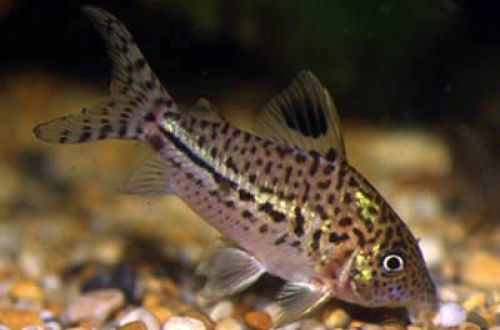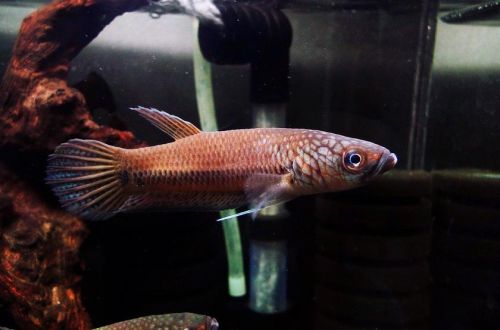
Kadinala
Cardinal, scientific name Tanichthys albonubes, belongs to the Cyprinidae family. The most popular aquarium fish, easy to keep and breed. As of 2010, there are four well-established breeding color forms, but only two of them are most widely used – close to natural color and with a predominance of red.
Zamkatimu
Habitat
The homeland of the species is the territory of modern China. Currently, fish are practically not found in the wild and are on the verge of extinction, listed in the Red Book. Several relict populations have been found in the coastal province of Guangdong (southern China) and in the province of Quang Ninh, northeast Vietnam. They live in slow-flowing rivers and streams, prefer to stay at shallow depths up to 60 cm near dense coastal aquatic vegetation.
Zambiri mwachidule:
- Kuchuluka kwa aquarium - kuchokera ku 60 malita.
- Kutentha - 14-22 ° C
- Mtengo pH - 6.0-8.5
- Water hardness – soft to hard (5-21dGH)
- Mtundu wa substrate - iliyonse
- Kuwala - kuchepetsedwa
- Madzi amchere - ayi
- Kusuntha kwa madzi - kufooka kwa madzi kapena madzi
- Kukula kwa nsomba kumafika 4 cm.
- Chakudya - chakudya chilichonse
- Kutentha - nsomba yamtendere yabata
- Kusunga gulu la anthu 10
Kufotokozera
Adults reach a length of 4 cm. Females are somewhat larger than males, but less colorful. There are several color forms. One is closer to natural coloration, the dominant color is gray with a wide bright pink stripe stretching from head to tail. The wide fins have a pale yellow edging. Another form has a similar color, but with a pronounced red pigment, which is painted on the back of the body, tail and edges of the fins.
Food
They accept all types of dry, frozen and live food. A combination of different species is the most preferred option, in this case the fish show their best color. Feed 2-3 times a day in the amount eaten in 5 minutes, remove leftovers in a timely manner to prevent water pollution.
Kusamalira ndi kusamalira, makonzedwe a aquarium
The recommended volume of the tank for one flock of fish starts from 60 liters. The design is arbitrary, however, a combination of a dark substrate and a certain amount of floating plants is considered the best option. Artificial or natural snags, roots and / or branches of trees are used as decor.
The standard set of equipment consists of filtration and lighting systems, an aerator. The cardinal prefers relatively low temperatures, so there is no need for a heater if the aquarium is set up in a living area.
Water conditions are characterized by a weak internal flow, temperature, pH and dGH parameters are in a wide acceptable range of values, so the preparation of water is not associated with great difficulties, in most cases it is enough to defend it during the day.
Kukonzekera kwa Aquarium kumakhala mlungu uliwonse m'malo mwa madzi (20-25% ya voliyumu) ndi madzi atsopano, kuyeretsa nthawi zonse gawo lapansi kuchokera ku zinyalala za organic ndi kuchotsa zolengeza pagalasi.
Khalidwe ndi Kugwirizana
Calm peace-loving fish, goes well with other species of similar size and temperament, able to live in similar temperature conditions. The content is flocking from 10 individuals of both sexes; within the group, males are forced to compete with each other for the attention of females, which contributes to an increase in the brightness of their color.
Kuswana / kuswana
Cardinal refers to spawning species, females scatter eggs in the water column, and males at this moment fertilize it. Parental instincts are poorly developed, immediately after spawning, the fish can eat their own caviar and fry that have appeared.
Kuswana kumalimbikitsidwa kuti kuchitidwe mu thanki ina - m'madzi amadzimadzi, kuti muteteze ana ku nsomba zazikulu. Mapangidwewo ndi osavuta, chidwi chachikulu chimaperekedwa pansi, chiyenera kukhala ndi tinthu tating'onoting'ono tating'ono tokwanira tomwe sitigwirizana mwamphamvu, kupanga voids, mwachitsanzo, miyala kapena mikanda yokongoletsa magalasi. Pamene mazirawo amira pansi, ambiri a iwo amagwera m’zimenezi ndipo motero amakhala osafikirika ndi nsomba. Zotsatira zofananira zimathekanso mukamagwiritsa ntchito mauna abwino, omwe amakhazikika pansi.
Njira ina yowonetsetsera kutetezedwa kwa mazira ndikugwiritsa ntchito zomera zazing'ono zomwe zikukula pang'ono kapena mosses monga Riccia zoyandama ndi Javanese moss, zomwe zimabzalidwa pamwamba pa gawo lapansi (panthawiyi, nthaka ikhoza kukhala iliyonse) . Wondiweyani m'nkhalango za zomera angapereke odalirika pogona mazira palibe choipa kuposa wapadera nthaka.
Kukula kwa aquarium yoberekera nthawi zambiri kumakhala malita 20-30, odzaza theka. Zida zomwe zimagwiritsidwa ntchito ndi mpweya, chotenthetsera ndi fyuluta yosavuta ya siponji yamphamvu yochepa kuti mupewe kuyamwa mazira ndi mwachangu mwangozi. Kubereketsa kumachitika mu kuwala kocheperako, kotero poyamba sipafunika gwero la kuwala.
The impetus for the beginning of the mating season is the establishment of a water temperature in the region of the upper permissible mark of 20–21 ° C at a neutral or slightly acidic pH value, as well as the inclusion of protein foods in the daily diet – bloodworms, daphnia, brine shrimp in live or frozen form.
After some time, the females become noticeably rounder, and the males will begin to actively show signs of attention to their chosen ones. At this point, you should prepare a separate tank and fill it with water from the general aquarium, then transplant several females and the most colorful males there. The easiest way to determine the end of spawning is by females, they will become slender.
Nsomba zabwezedwa. Fry idzawoneka mu maola 48 - 60, ndipo tsiku lina adzayamba kusambira momasuka. Dyetsani ndi zakudya zapadera zosawoneka bwino zodyetsera nsomba zazing'ono zam'madzi.
Nsomba matenda
Due to long-term hybridization and inbreeding, undesirable consequences appeared in the form of weak immunity and a high proportion of congenital malformations among juveniles. A balanced diet and suitable living conditions reduce the risk of disease, but do not eliminate them. Read more about symptoms and treatments in the Aquarium Fish Diseases section.





